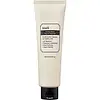What's inside
What's inside
 Key Ingredients
Key Ingredients

 Benefits
Benefits

 Concerns
Concerns

 Ingredients Side-by-side
Ingredients Side-by-side

Water
Skin ConditioningGlycerin
HumectantSodium Cocoyl Glycinate
CleansingSodium Cocoyl Isethionate
CleansingCocamidopropyl Betaine
CleansingMyristic Acid
CleansingGlycol Distearate
EmollientAcrylates Copolymer
Lauric Acid
CleansingPEG-120 Methyl Glucose Dioleate
EmulsifyingPhenoxyethanol
PreservativeCaprylyl Glycol
EmollientChlorphenesin
AntimicrobialParfum
MaskingGluconolactone
Skin ConditioningSodium Hydroxide
BufferingHydroxyethylcellulose
Emulsion StabilisingDisodium EDTA
Sodium Hyaluronate
HumectantWater, Glycerin, Sodium Cocoyl Glycinate, Sodium Cocoyl Isethionate, Cocamidopropyl Betaine, Myristic Acid, Glycol Distearate, Acrylates Copolymer, Lauric Acid, PEG-120 Methyl Glucose Dioleate, Phenoxyethanol, Caprylyl Glycol, Chlorphenesin, Parfum, Gluconolactone, Sodium Hydroxide, Hydroxyethylcellulose, Disodium EDTA, Sodium Hyaluronate
Water
Skin ConditioningGlycerin
HumectantSodium Cocoyl Glycinate
CleansingSodium Lauroyl Glutamate
1,2-Hexanediol
Skin ConditioningHydroxypropyl Starch Phosphate
Lauryl Betaine
CleansingHydroxyacetophenone
AntioxidantEthylhexylglycerin
Skin ConditioningSodium Chloride
MaskingDecylene Glycol
Skin ConditioningButylene Glycol
HumectantDipropylene Glycol
HumectantLaminaria Japonica Extract
Skin ProtectingEclipta Prostrata Leaf Extract
Skin ConditioningNigella Sativa Seed Extract
PerfumingHydrogenated Lecithin
EmulsifyingFructooligosaccharides
HumectantAmaranthus Caudatus Seed Extract
Skin ConditioningUlmus Davidiana Root Extract
Skin ConditioningBeta-Glucan
Skin ConditioningFicus Carica Fruit Extract
HumectantCentella Asiatica Extract
CleansingRubus Fruticosus Fruit Extract
AstringentHydrolyzed Hyaluronic Acid
HumectantTuber Melanosporum Extract
HumectantTocopherol
AntioxidantCeramide NP
Skin ConditioningGlycine Soja Seed Extract
Skin ConditioningAspartic Acid
MaskingAcetyl Hexapeptide-8
HumectantWater, Glycerin, Sodium Cocoyl Glycinate, Sodium Lauroyl Glutamate, 1,2-Hexanediol, Hydroxypropyl Starch Phosphate, Lauryl Betaine, Hydroxyacetophenone, Ethylhexylglycerin, Sodium Chloride, Decylene Glycol, Butylene Glycol, Dipropylene Glycol, Laminaria Japonica Extract, Eclipta Prostrata Leaf Extract, Nigella Sativa Seed Extract, Hydrogenated Lecithin, Fructooligosaccharides, Amaranthus Caudatus Seed Extract, Ulmus Davidiana Root Extract, Beta-Glucan, Ficus Carica Fruit Extract, Centella Asiatica Extract, Rubus Fruticosus Fruit Extract, Hydrolyzed Hyaluronic Acid, Tuber Melanosporum Extract, Tocopherol, Ceramide NP, Glycine Soja Seed Extract, Aspartic Acid, Acetyl Hexapeptide-8
 Reviews
Reviews

Ingredients Explained
These ingredients are found in both products.
Ingredients higher up in an ingredient list are typically present in a larger amount.
Glycerin is already naturally found in your skin. It helps moisturize and protect your skin.
A study from 2016 found glycerin to be more effective as a humectant than AHAs and hyaluronic acid.
As a humectant, it helps the skin stay hydrated by pulling moisture to your skin. The low molecular weight of glycerin allows it to pull moisture into the deeper layers of your skin.
Hydrated skin improves your skin barrier; Your skin barrier helps protect against irritants and bacteria.
Glycerin has also been found to have antimicrobial and antiviral properties. Due to these properties, glycerin is often used in wound and burn treatments.
In cosmetics, glycerin is usually derived from plants such as soybean or palm. However, it can also be sourced from animals, such as tallow or animal fat.
This ingredient is organic, colorless, odorless, and non-toxic.
Glycerin is the name for this ingredient in American English. British English uses Glycerol/Glycerine.
Learn more about GlycerinSodium Cocoyl Glycinate is a cleansing agent. It can be naturally derived or synthetically-created.
As a surfactant, it helps clean your skin by gathering dirt, oil, and other pollutants to be rinsed away more easily.
Water. It's the most common cosmetic ingredient of all. You'll usually see it at the top of ingredient lists, meaning that it makes up the largest part of the product.
So why is it so popular? Water most often acts as a solvent - this means that it helps dissolve other ingredients into the formulation.
You'll also recognize water as that liquid we all need to stay alive. If you see this, drink a glass of water. Stay hydrated!
Learn more about Water